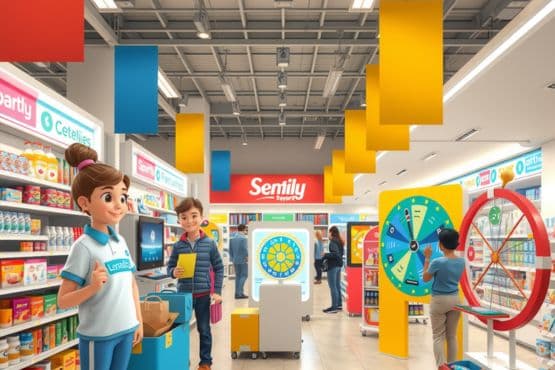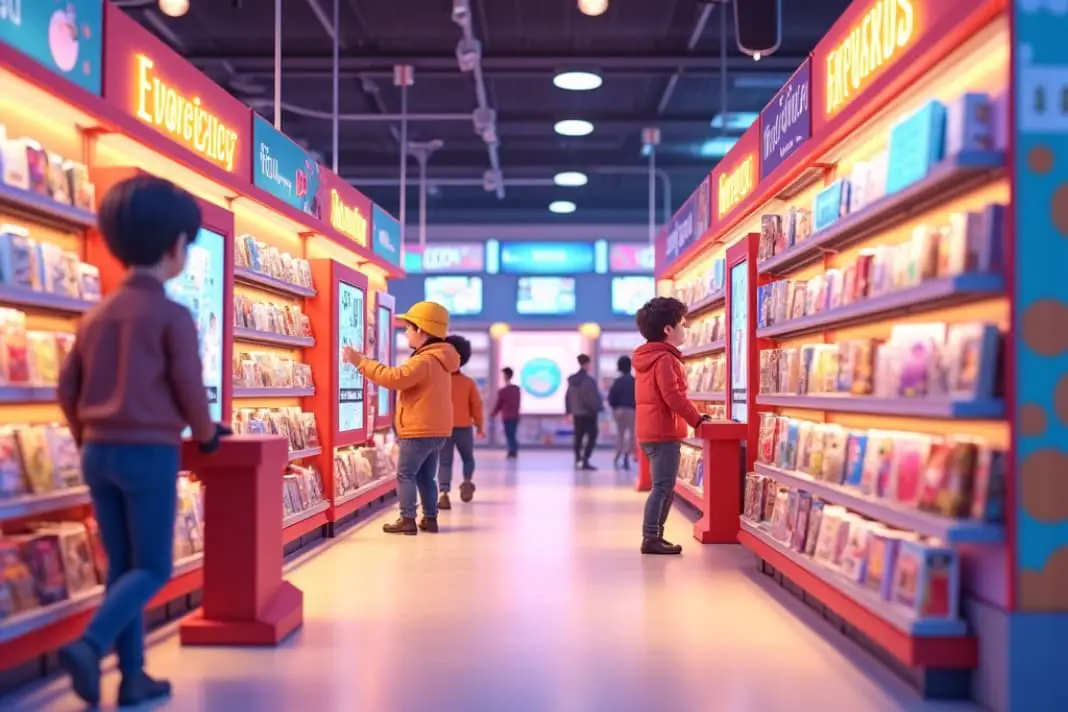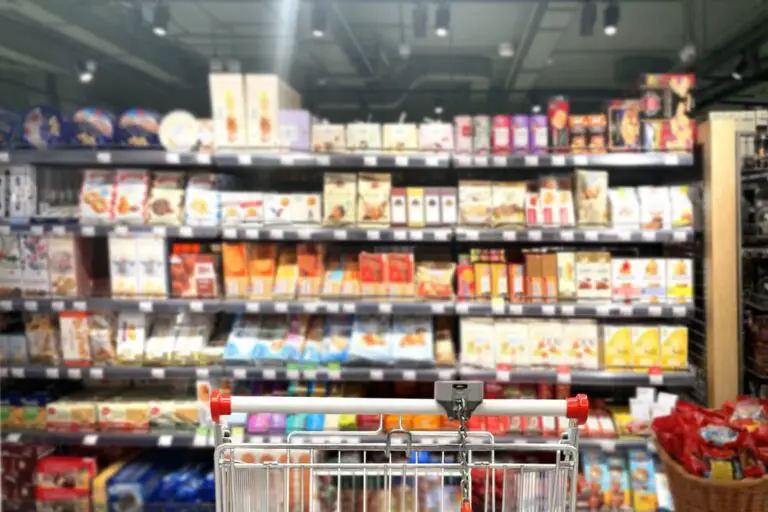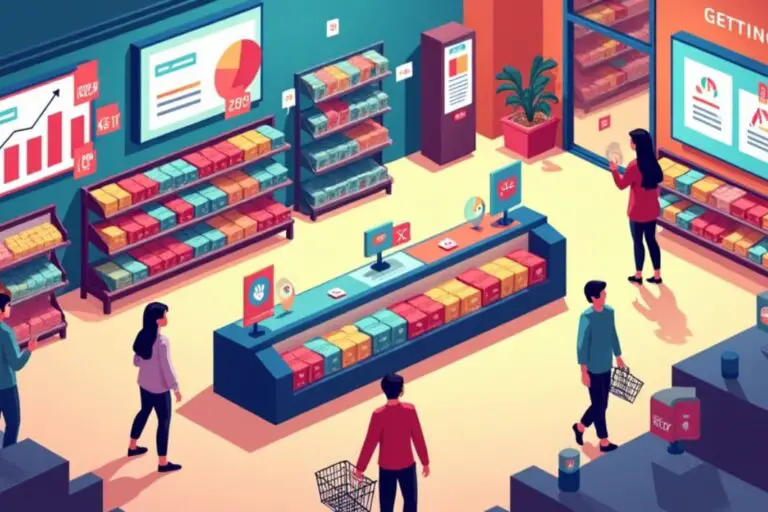Before diving into the comprehensive guide, here are some quick tips for retailers looking to get started with gamification:
- Start small: Begin by implementing simple game mechanics, such as points or badges, in your existing loyalty program or mobile app.
- Know your audience: Understand your target customers’ preferences and tailor your gamification strategies accordingly.
- Focus on engagement: Prioritize game elements that encourage active participation and emotional connection with your brand.
- Monitor and adapt: Continuously track performance metrics and adjust your approach based on customer feedback and data insights.
Now, let’s explore the world of gamification in retail in greater depth.
Gamification in Retail
In the landscape of modern retail, businesses are constantly seeking innovative ways to captivate customers and drive success. One powerful strategy that has emerged as a game-changer is gamification in retail. By seamlessly integrating interactive elements and game mechanics into the shopping experience, retailers are revolutionizing customer engagement and loyalty.
“Gamification is the process of using game thinking and game mechanics to solve problems and engage users.” – Gabe Zichermann, gamification expert
At its core, gamification involves applying game design principles and features to non-game contexts, such as retail environments. This approach taps into the innate human desires for competition, achievement, and rewards, creating immersive experiences that motivate and delight customers.
The Power of Gamification
Gamification is not just a passing fad; it’s a data-driven strategy that yields tangible results. According to a report by Mordor Intelligence, the global gamification market is expected to reach $30.7 billion by 2025, with retail and e-commerce being the largest contributors to this growth.

As customers increasingly seek personalized and engaging shopping experiences, gamification offers retailers a powerful tool to differentiate themselves and build lasting relationships with their audience.
Benefits of Gamification with Data
Gamification is not just about fun and games; it’s a data-driven approach that delivers measurable benefits for retailers.
By leveraging game mechanics in retail, businesses can enhance customer experiences, increase brand loyalty, and drive significant growth.
Let’s explore the key advantages of gamification, supported by compelling statistics.
Enhanced Customer Engagement
One of the primary benefits of gamification is its ability to captivate and engage customers on a deeper level.
By incorporating interactive elements and challenges into the shopping journey, retailers can create a sense of excitement and novelty that keeps customers coming back for more.
Did You Know? Brands that implement gamification have seen engagement and loyalty increase by an impressive 30%, according to a study by Snipp.
Real-world retailers across various industries have successfully leveraged gamification to boost engagement.
For example, Nike’s “NikeFuel” program rewards customers for physical activity, creating a sense of achievement and encouraging them to interact with the brand beyond product purchases.
Increased Brand Loyalty
Gamification strategies, such as personalized rewards and tiered loyalty programs, foster a strong emotional connection between customers and brands. By offering tailored incentives and recognition, retailers can make each customer feel valued and appreciated.
Research by Gamification Co. reveals that 70% of top 2,000 global organizations will have at least one gamified application by 2024.
Pro Tip: Use customer data to create personalized gamification experiences that resonate with individual preferences and behaviors.
Improved Sales and ROI
Beyond engagement and loyalty, gamification directly impacts the bottom line. Retailers that integrate gamification into their sales processes have experienced remarkable results:
| Gamification Impact | Statistics |
|---|---|
| Sales conversion rates | 25.3% average increase |
| Customer acquisitions | Up to 700% increase |
| Average order value | 20% increase |
These numbers underscore the effectiveness of gamification in influencing consumer behavior and driving purchases.
Myth vs. Reality
Despite the proven benefits, some retailers may hesitate to embrace gamification due to misconceptions. Let’s debunk a common myth:
Myth: Gamification is only for large retailers with big budgets.
Reality: Gamification can be scaled to suit businesses of all sizes. Even small retailers can implement simple game mechanics, such as point systems or progress bars, to enhance customer engagement.
Key Gamification Strategies by Segment
To maximize the impact of gamification, retailers must tailor their approaches to different customer segments and touchpoints.
Let’s explore some key gamification strategies across various domains.
Loyalty Programs
Loyalty programs are a prime avenue for implementing gamification. High-performing examples showcase the effectiveness of this approach:
- Sephora’s Beauty Insider: Offers tiered rewards based on annual spending, exclusive perks, and personalized recommendations.
- Starbucks Rewards: Gamifies the coffee-buying experience with stars, levels, and redeemable rewards.
Pro Tip: Use a points-based system with achievable milestones and desirable rewards to motivate customers to engage with your loyalty program.
In-Store Competitions
Bringing gamification into the physical retail space can create excitement and drive foot traffic.
Consider these ideas:
- Scavenger hunts: Hide QR codes or clues throughout the store, leading customers to discover new products or unlock discounts.
- Skill-based challenges: Host contests related to your products, such as a cooking competition for a kitchenware store or a makeup tutorial contest for a beauty brand.
Mobile App Engagement
As mobile commerce continues to surge, gamification plays a crucial role in enhancing the user experience. Integrate game elements into your retail app:
- Progress tracking: Use progress bars or checklists to motivate customers to complete actions, such as making a purchase or leaving a review.
- Mini-games: Incorporate simple games that reward customers with points or discounts for playing.
Real-World Example: Amazon’s “Treasure Truck” alerts app users about limited-time, location-specific deals, creating a sense of urgency and excitement.
Social Media Challenges
Leverage the power of social media to extend your gamification efforts:
- Hashtag contests: Encourage customers to share photos or videos featuring your products with a branded hashtag for a chance to win prizes.
- Referral rewards: Offer bonus points or discounts to customers who successfully refer friends to your brand.
Pro Tip: Partner with influencers to create sponsored challenges that align with your brand values and target audience.
Real-World Success Stories
To fully grasp the potential of gamification in retail, let’s examine some real-world success stories that have set the bar high.
Alibaba’s “Ant Forest”
Chinese e-commerce giant Alibaba launched “Ant Forest,” a gamified feature within the Alipay app that rewards users for making environmentally friendly choices, such as walking instead of driving or paying bills online.
Users earn virtual “green energy” points, which can be used to plant real trees in arid regions of China.
Impact: Over 500 million users have participated, planting more than 100 million real trees and reducing carbon emissions by 7.9 million tons.
Nike’s “NikeFuel”
Nike’s “NikeFuel” program tracks users’ physical activity using wearable technology and rewards them with points for each movement. Users can compete with friends, unlock achievements, and redeem points for exclusive products or experiences.
Impact: NikeFuel has driven a significant increase in customer engagement and loyalty, with users reporting higher motivation to stay active.
My Starbucks Rewards
Starbucks’ gamified loyalty program rewards customers with stars for each purchase, which can be redeemed for free drinks or food.
The program features tiered levels, personalized challenges, and exclusive perks for top-tier members.
Impact: Starbucks Rewards has over 16 million active members in the U.S. alone, accounting for 40% of the company’s sales.
Implementation Blueprint for Retailers
Implementing gamification in your retail strategy may seem daunting, but with a clear blueprint, you can seamlessly integrate these elements into your existing systems.
Here’s a step-by-step guide to getting started:
- Define your goals: Clearly outline what you want to achieve through gamification, whether it’s increasing customer engagement, driving sales, or promoting specific behaviors.
- Know your audience: Understand your target customers’ preferences, motivations, and pain points to create gamification experiences that resonate with them.
- Choose the right mechanics: Select game elements that align with your goals and audience, such as points, badges, leaderboards, or challenges.
- Start small and scale up: Begin with a pilot program or a single touchpoint, such as your loyalty program or mobile app, and gradually expand your gamification efforts based on customer feedback and results.
- Communicate effectively: Clearly explain the rules, rewards, and benefits of your gamification program to customers through various channels, such as in-store signage, email, or social media.
- Monitor and optimize: Continuously track performance metrics and gather customer feedback to identify areas for improvement and adapt your gamification strategies accordingly.
Pro Tip: Use A/B testing to experiment with different game mechanics and rewards to determine what resonates best with your audience.
Measuring ROI and Performance Metrics
To gauge the success of your gamification efforts, it’s crucial to track key performance indicators (KPIs) and measure return on investment (ROI).
Here are some essential metrics to monitor:
- Engagement: Track metrics such as active users, time spent on your app or website, and social media interactions to evaluate customer engagement levels.
- Conversion: Measure how gamification impacts conversion rates, such as the percentage of customers who make a purchase or redeem a reward.
- Customer lifetime value (CLV): Analyze how gamification influences customer loyalty and long-term spending behavior.
- Cost per acquisition (CPA): Compare the cost of acquiring new customers through gamification campaigns versus traditional marketing methods.
Pro Tip: Use customer surveys or feedback forms to gather qualitative insights on how gamification impacts their shopping experience and loyalty.
Addressing Challenges and Best Practices
While gamification offers numerous benefits, it’s essential to navigate potential challenges and adhere to best practices for long-term success.
Here are some key considerations:
Ensuring Relevance
To maintain customer interest and engagement, ensure that your gamification elements are relevant to your brand and target audience.
Regularly update and refresh your challenges, rewards, and themes to keep the experience fresh and exciting.
Balancing Complexity
Strike a balance between simplicity and depth in your gamification design. While complex mechanics can engage hardcore gamers, they may alienate casual customers. Focus on creating accessible and intuitive experiences that cater to a wide range of users.
Maintaining Fairness
Ensure that your gamification program is transparent and fair to all participants. Clearly communicate the rules, criteria, and rewards to avoid confusion or frustration.
Regularly monitor and address any potential exploits or loopholes that may undermine the integrity of your system.
Integrating with Existing Systems
Seamlessly integrate gamification elements into your existing retail infrastructure, such as your e-commerce platform, loyalty program, or inventory management system.
Ensure that the user experience is cohesive and consistent across all touchpoints.
Best Practice: Collaborate with cross-functional teams, including marketing, sales, and IT, to ensure a smooth implementation and ongoing support for your gamification initiatives.
Emerging Trends in Gamification
As gamification continues to evolve, new trends are shaping the future of retail experiences. Keep an eye on these emerging developments:
Personalized Challenges
Leverage customer data and machine learning algorithms to create personalized gamification experiences that adapt to individual preferences and behaviors.
For example, a fashion retailer could offer style challenges tailored to a customer’s previous purchases and browsing history.
Augmented Reality (AR) Integration
Incorporate AR technology into your gamification strategy to create immersive and interactive experiences. For instance, a furniture store could use AR to allow customers to visualize how products would look in their homes and earn rewards for sharing their virtual designs on social media.
Real-World Example: IKEA’s “Place” app uses AR to help customers visualize furniture in their spaces, driving engagement and sales.
Gamified Sustainability
Align your gamification efforts with sustainability goals to appeal to environmentally conscious consumers. Incentivize eco-friendly behaviors, such as recycling or choosing energy-efficient products, through rewards and recognition.
Social Gamification
Integrate social elements into your gamification strategy to foster a sense of community and competition among customers.
Encourage user-generated content, such as product reviews or social media posts, and reward top contributors with special perks or status.
Pro Tip: Host live streaming events or contests on platforms like Twitch or TikTok to engage younger audiences and showcase your brand’s personality.
Conclusion
Gamification is a powerful tool for retailers looking to differentiate themselves, engage customers, and drive long-term success. By understanding the benefits, implementing key strategies, and staying ahead of emerging trends, retailers can unlock the full potential of gamification.
To embark on your gamification journey, start by assessing your current retail landscape and identifying opportunities for integration.
Collaborate with cross-functional teams to develop a comprehensive gamification roadmap that aligns with your brand’s goals and values. Remember to start small, measure your results, and continuously optimize based on customer feedback and data insights.




